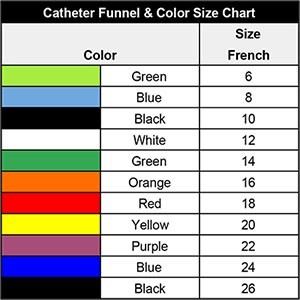The charge nurse brings a #18 urinary catheter with a 30 mL balloon to the practical nurse (PN) who is preparing to insert a catheter in a female client who weighs 50 kg. Which action should the PN take first?
Obtain a 30 mL syringe and a vial of sterile water.
Ask the client if she has previously been catheterized.
Consult with the charge nurse about the catheter.
Position the client and observe the urinary meatus.
The Correct Answer is C
This is the first action that the PN should take because the catheter size and balloon volume are inappropriate for the client. A #18 urinary catheter is too large for a female client who weighs 50 kg, and a 30 mL balloon may cause bladder trauma or discomfort. The PN should consult with the charge nurse and obtain a smaller catheter (such as #14 or #16) with a 10 mL balloon.

A. Obtaining a 30 mL syringe and a vial of sterile water is not the first action because it does not address the issue of the catheter size and balloon volume.
B. Asking the client if she has previously been catheterized is not the first action because it does not address the issue of the catheter size and balloon volume.
D. Positioning the client and observing the urinary meatus is not the first action because it does not address the issue of the catheter size and balloon volume.
Nursing Test Bank
Naxlex Comprehensive Predictor Exams
Related Questions
Correct Answer is C
Explanation
The correct answer is choice C. Red welts widespread over the chest.
Choice A rationale:
Ulceration on the corner of the upper lip does not indicate a need for loratadine administration. Loratadine is an antihistamine commonly used to relieve symptoms of allergies such as sneezing, runny nose, and itchy or watery eyes. Ulceration on the lip is not associated with an allergic reaction.
Choice B rationale:
Ecchymosis and petechiae on the legs are not related to the need for loratadine. These findings suggest potential bleeding or clotting disorders, and loratadine does not address such issues.
Choice C rationale:
Red welts widespread over the chest are indicative of hives (urticaria), which are often caused by allergic reactions. Loratadine can help alleviate the symptoms of hives by blocking histamine release, making it an appropriate choice for this condition.
Choice D rationale:
Red papules and pustules on the face are unlikely to be treated with loratadine. These skin manifestations may be related to various dermatological conditions, but not necessarily allergic reactions that loratadine is primarily used to manage.
Correct Answer is D
Explanation
The PN should directly observe the UAP's performance and provide feedback and guidance as needed. This can help ensure that the UAP follows the standards of care and respects the client's dignity and preferences.
The other options are not correct because:
A. Asking another UAP to help the oriented may not be appropriate or necessary, as it may interfere with the orientation process and create confusion or conflict.
B. Verifying with the client that the bath was complete and thorough may not be sufficient or reliable, as the client may not be able to assess the quality of care or may not want to complain.
C. Inspecting the client's skin near the end of the bathing procedure may not be timely or comprehensive, as it may miss some aspects of care or some problems that occurred during the bath.
Whether you are a student looking to ace your exams or a practicing nurse seeking to enhance your expertise , our nursing education contents will empower you with the confidence and competence to make a difference in the lives of patients and become a respected leader in the healthcare field.
Visit Naxlex, invest in your future and unlock endless possibilities with our unparalleled nursing education contents today
Report Wrong Answer on the Current Question
Do you disagree with the answer? If yes, what is your expected answer? Explain.
Kindly be descriptive with the issue you are facing.
